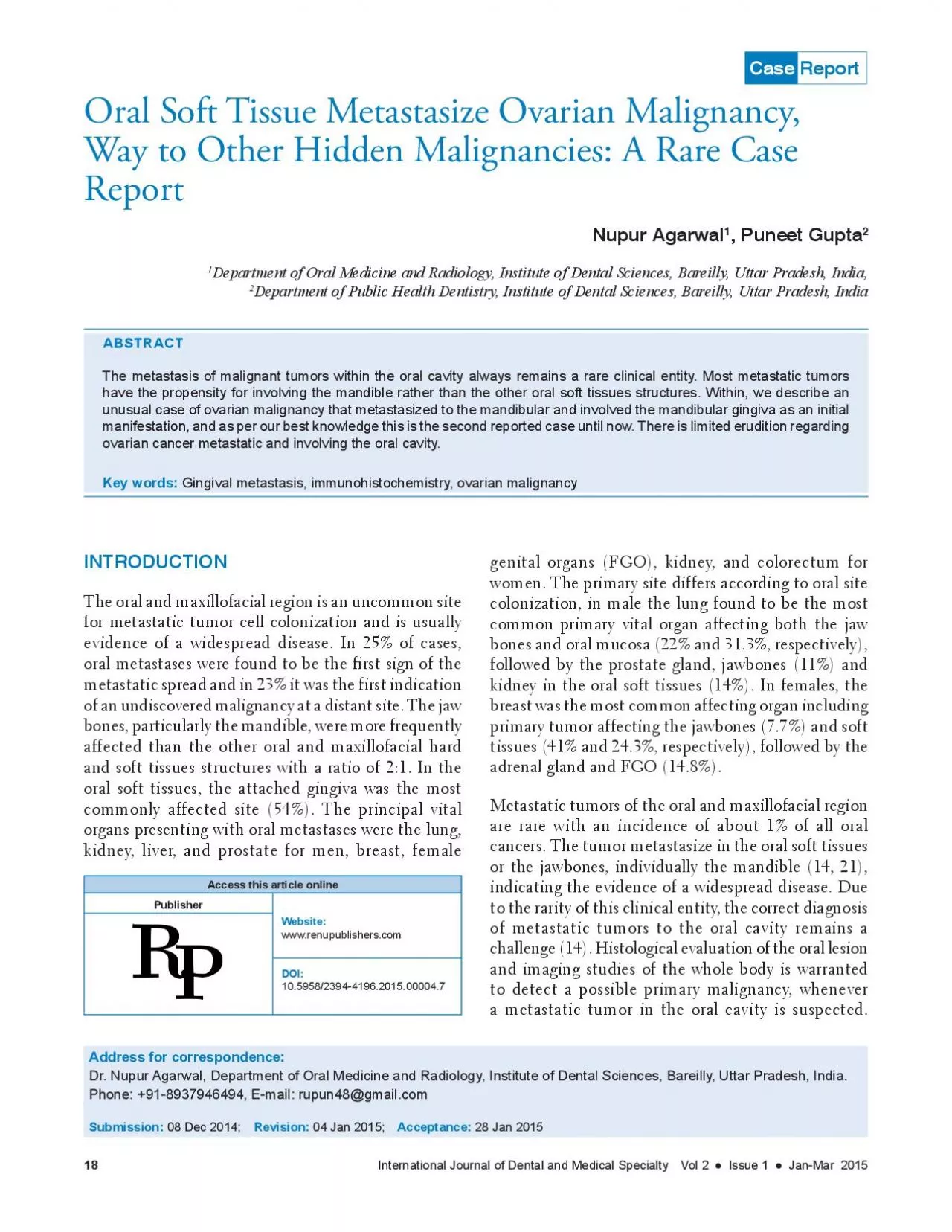

The oral and maxillofacial region is an uncommon site evidence of a widespread disease In 25 of cases oral metastases were found to be the first sign of the Address for correspondence Dr Nupur A ID: 944543
Download Pdf The PPT/PDF document "Gingival metastasis immunohistochemistry..." is the property of its rightful owner. Permission is granted to download and print the materials on this web site for personal, non-commercial use only, and to display it on your personal computer provided you do not modify the materials and that you retain all copyright notices contained in the materials. By downloading content from our website, you accept the terms of this agreement.
Gingival metastasis, immunohistochemistry, ovarian malignancy The oral and maxillofacial region is an uncommon site evidence of a widespread disease. In 25% of cases, oral metastases were found to be the first sign of the Address for correspondence: Dr. Nupur Agarwal, Department of Oral Medicine and Radiology, Institute of Dental Sciences, Bareilly, Uttar Pradesh, India. Report Agarwal and Gupta: Oral and Ovarian Malignancy International Journal of Dental and Medical Specialty Vol 2 Issue 1 Jan-Mar 2015relation to 16, 17, 26, 27, Grade 1 mobility in relation gingival recession with generalized stains and calculus was present.Hence considering the history and clinical examination given in relation left mandibular alveolar ridge was given. Differential diagnosis of malignant ulcer and Vital stain
ing was performed, and the lesion took the toluidine blue stain, and hence it was suggestive of dysplastic changes. Orthopantomograph was taken to see the bone involvement no finding was seen in the area of interest. Full body radiographs were taken and were suggestive of generalized osteoporosis. Biopsy was taken from the ulcer-proliferative growth and was sent for histopathological examination. Histopathological findings were suggestive of anaplastic carcinoma[Figures 1-7]. However, it revealed the presence of cells that were giving the coffee bean appearance with the central grooving that are the characteristic features of granulosa cell tumor of the ovary. Hence, patient was referred to the where ultrasound of the abdomen was advised and which revealed the presence of large ovarian mass and was
suggestive of ovarian malignancy.As the diagnosis has not been confirmed by histopathology, it was sent for immunochemistry, which revealed that inhibin and vimentin were the positive markers, which was suggestive of granular cell tumor of an ovary. Hence considering the history, clinical examination, histopathology and immunohistochemistry (IHC) final diagnosis of secondary metastasis from ovary was given. Patient was called up for treatment, but she did not report, on enquiring we came to know that patient was expired. Metastasis is defined as the spread of tumor by invasion masses are formed at the site of lodgment. Metastatic tumors to the oral region are uncommon, comprising e uncommon, comprising These tumors, however, are of great clinical significance, undiscovered malignancy at a distant
primary site or of tumors metastatic to the oral region are the breast, lung, and kidney.. The lung is the most common source of metastases to the oral soft tissues, whereas the breast is the most common source of metastatic molar area being the most frequently involved site.lesion to be a metastatic tumor include: (a) Histological and the jaw lesion are identical from a histological standpoint, including special staining and other studies such as electron microscopy, (b) the fact that the MT (c) the fact that the possibility of direct extension to the jawbones from a primary oral tumor can be excluded, (d) genetic analysis - namely, the identical in the metastatic jaw lesion, can be a significant The exact mechanism of is not entirely understood. However, autopsy records patterns of metastases.
For many tumors the nearest anatomic site encountered will be the most common site for metastatic-colony formation. Other tumors are more selective and by-pass nearby proximal organs and selectively colonize in a particular distal organ. The primary tumors that metastasize to the oral region and the jawbones probably belong to the group of more selective tumors. The common routes of metastases by distant tumors to the oral region and/or the jawbones are via the lymphatic channels or by hematogenous spread.Each of the three main categories of ovarian tumors has distinctive immunohistochemical features and stains can be used to suggest or confirm a diagnosis. IHC is often useful to differentiate between primary ovarian adenocarcinoma and metastatic adenocarcinomas specially those of colorectal o
rigin. It is also helpful in diagnosing other ovarian metastatic tumors, especially in the absence of a known primary elsewhere. Various markers may also be of value in peritoneal biopsy or fluid specimens when faced with an adenocarcinoma of unknown primary. Agarwal and Gupta: Oral and Ovarian Malignancy International Journal of Dental and Medical Specialty Vol 2 Issue 1 Jan-Mar 20156. Coward JI, Middleton K, Murphy F. New perspectives on targeted therapy in ovarian cancer. Int J Womens Health 2015;7:189-203.7. Cormio G, Rossi C, Cazzolla A, Resta L, Loverro G, Greco P, Distant metastases in ovarian carcinoma. Int J Gynecol Cancer How to cite this article: Agarwal N, Gupta P. Oral Soft Tissue Metastasize Ovarian Malignancy, Way to Other Hidden Malignancies: A Rare Case Report. ict of Interes